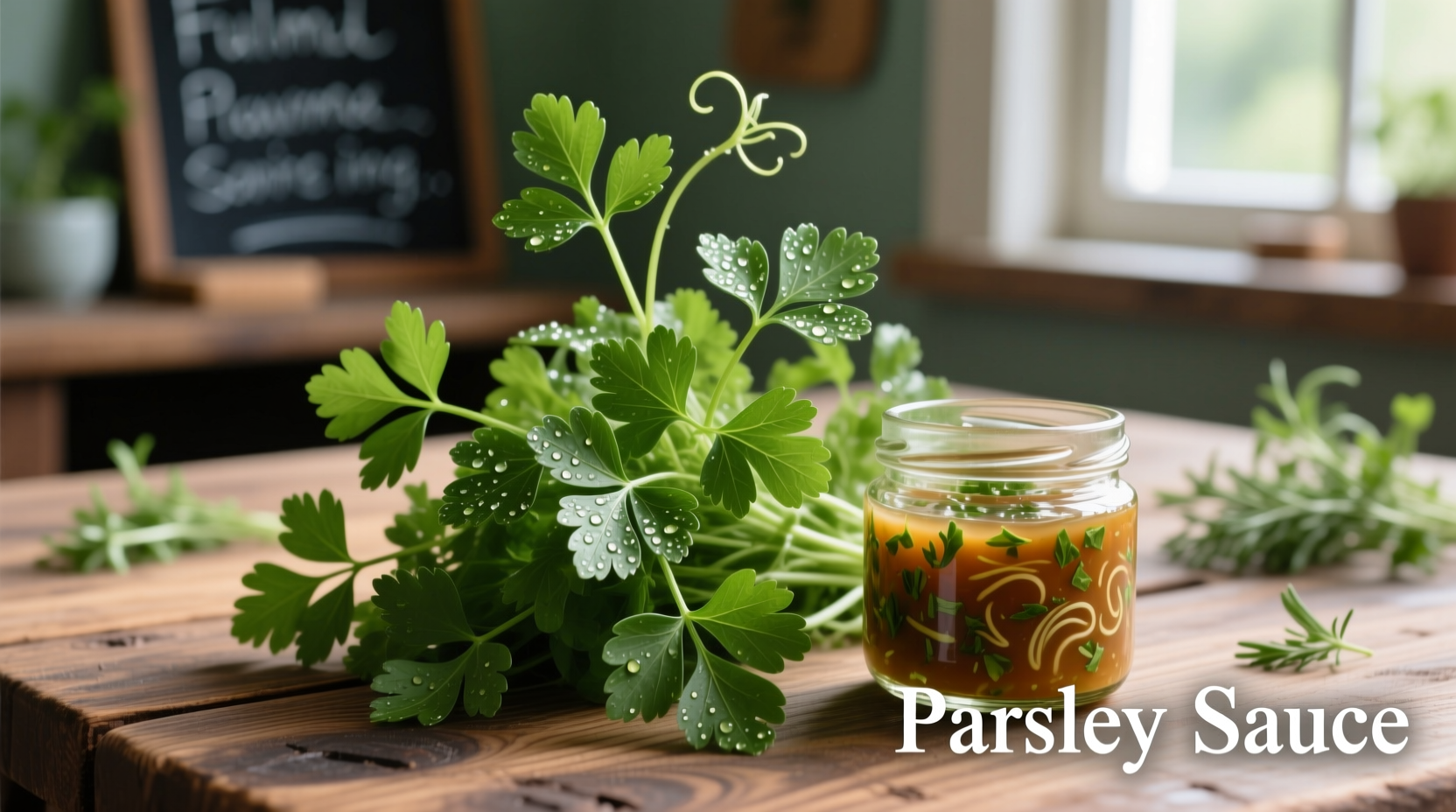When crafting the perfect sauce, understanding how parsley interacts with other ingredients transforms ordinary dishes into culinary masterpieces. This versatile herb isn't just a garnish—it's a flavor catalyst that works differently depending on sauce composition, preparation method, and cultural tradition.
The Science Behind Parsley's Sauce Compatibility
Parsley's unique chemical profile makes it exceptionally versatile in sauce applications. The herb contains significant amounts of apiol and myristicin, compounds that interact differently with various sauce bases. According to research from the USDA Agricultural Research Service, flat-leaf parsley contains 23% more volatile flavor compounds than curly varieties, explaining its superior performance in cooked sauces.
When added to acidic components like lemon juice or vinegar, parsley's chlorophyll breaks down more slowly, preserving its fresh flavor. In emulsified sauces like hollandaise, the herb's natural oils help stabilize the mixture while adding subtle complexity without overpowering the delicate balance.
Light Sauce Applications: Where Parsley Shines
For quick, fresh sauces that showcase parsley's bright character, timing and preparation method prove crucial. Professional chefs at Le Cordon Bleu Paris note that adding parsley at the final stage preserves its volatile compounds, while incorporating it earlier allows flavors to meld more thoroughly.
| Sauce Type | Best Parsley Variety | Optimal Ratio | Preparation Tip |
|---|---|---|---|
| Lemon Butter | Flat-leaf | 2 tbsp per 4 oz butter | Add after removing from heat |
| Chimichurri | Flat-leaf | 1 cup per 1/2 cup oil | Chop finely, rest 30 minutes |
| Vinaigrette | Curly or flat-leaf | 1.5 tbsp per 1/4 cup dressing | Whisk into emulsion |
| Gremolata | Flat-leaf | Equal parts with lemon zest | Prepare 15 minutes before serving |
Rich Sauce Integration: Subtle Enhancement Techniques
When working with richer sauces, parsley requires more strategic application. The Culinary Institute of America's flavor chemistry research shows that parsley's volatile compounds diminish significantly when exposed to temperatures above 160°F (71°C) for more than 5 minutes.
For hollandaise and bernaise sauces, incorporate finely minced parsley after the emulsion has stabilized. The herb's natural pectin helps maintain the sauce's structure while adding visual appeal. In tomato-based sauces, add parsley during the final simmering stage to preserve its fresh flavor without bitterness.

Historical Evolution of Parsley in Sauce Making
Parsley's journey from medicinal herb to culinary staple reveals why certain sauce pairings have endured for centuries. Historical records from the British Museum's food history archives show parsley's transition from apothecary shelves to kitchen gardens during the 16th century.
1500s: Initially used medicinally, then adopted in French and Italian sauces as a digestive aid
1700s: Emerged in classic French sauce preparations like sauce verte
1800s: Became standard in chimichurri after Spanish colonization of South America
1900s: Gained popularity in Middle Eastern zhug and toum variations
Present: Featured in modern fusion sauces combining traditional techniques with global ingredients
Contextual Limitations: When Parsley Doesn't Work
Despite its versatility, parsley has clear limitations in certain sauce applications. Food science research from Cornell University's Department of Food Science demonstrates that parsley's flavor compounds clash with strong dairy enzymes in aged cheeses, creating bitter off-notes.
Avoid using parsley in:
- Sauces with dominant aged cheese components
- Highly spiced curry sauces where its delicate flavor gets overwhelmed
- Sweet dessert sauces where its grassy notes create imbalance
- Long-simmered tomato sauces where it develops bitterness
Professional Technique Guide
Mastering parsley integration requires understanding both timing and preparation. When creating herb-infused oils for sauces, the University of Gastronomic Sciences in Italy recommends:
- Blanch flat-leaf parsley for 15 seconds in boiling water
- Immediately shock in ice water to preserve color
- Pat completely dry before blending with oil
- Store infused oils in airtight containers away from light
For immediate sauce applications, finely mince parsley and mix with a small amount of the sauce base before incorporating. This "pre-emulsification" technique prevents clumping and ensures even distribution of flavor.
Troubleshooting Common Issues
Even experienced cooks encounter challenges with parsley in sauces. When parsley turns sauces bitter, it's typically due to:
- Overcooking (especially in acidic sauces)
- Using stems instead of leaves in delicate preparations
- Improper storage causing oxidation before use
Rescue bitter parsley sauces by adding a small amount of honey (1/4 tsp per cup) or lemon zest to balance flavors. For sauces where parsley has darkened unattractively, a quick re-emulsification with fresh butter can restore vibrancy.
What's the difference between using flat-leaf and curly parsley in sauces?
Flat-leaf parsley contains higher concentrations of flavor compounds and blends more smoothly into sauces. Curly parsley works better as a garnish due to its sturdier texture but can create a slightly bitter note when cooked extensively.
How much parsley should I use in a standard sauce recipe?
For most sauces, use 1-2 tablespoons of finely minced flat-leaf parsley per cup of sauce base. In raw sauces like chimichurri, you can increase to 1 cup of parsley per 1/2 cup of oil for a more pronounced herb flavor.
When should I add parsley to my sauce during preparation?
For cooked sauces, add parsley during the last 2-3 minutes of preparation. For cold sauces and dressings, incorporate parsley 15-30 minutes before serving to allow flavors to meld without losing freshness.
Can I substitute dried parsley for fresh in sauces?
Dried parsley lacks the vibrant flavor and chemical complexity of fresh. If substituting, use 1 teaspoon dried for every 1 tablespoon fresh, but recognize that the sauce will miss the bright, grassy notes that define fresh parsley's contribution.











 浙公网安备
33010002000092号
浙公网安备
33010002000092号 浙B2-20120091-4
浙B2-20120091-4